About National Cancer Survivorship Awareness Month
A cancer survivor is considered a survivor from the time of diagnosis until the end of life [1-3]. National Cancer Survivor Month, which starts on June 1 and ends on June 30, seeks to honor cancer survivors living in the United States.
What is National Cancer Survivors Day®?
National Cancer Survivors Day® is an annual observance held the first Sunday in June. “It is a celebration for those who have survived, an inspiration for those recently diagnosed, a gathering of support for families and an outreach to the community” [4].
Data and Statistics
In 2018, the latest year for which incidence data is available, in the United States, 1,708,921 new cancer cases were reported, and 599, 265 people died of cancer [5]. For every 100,000 people, 436 new cancer cases were reported and 149 people died of cancer [5].
With nearly 17 million people with a history of cancer in the United States and a little over 1.9 million new cases expected to be diagnosed in 2022, cancer continues to affect almost every American, whether through a close friend or family member, or through their own experiences [6].
The 2020 CDC Cancer Annual Report showed that overall cancer death rates decreased 1.5% on average per year from 2001 to 2017, decreasing more rapidly among men (by 1.8% per year) than among women (1.4% per year) [7]. A decline in death rates coupled by increases in incidence rates among women, children, and adolescents and young adults will likely increase the number of cancer survivors living in the U.S. [8]. By 2030, the number of cancer survivors is projected to increase by 31.4%, to 22.2 million [9]. Ultimately, the number of cancer survivors will grow, and their needs will increase as advances in cancer early detection and cancer treatment are made, and as the overall population ages, since cancer risk increases with age.
Best Practices for Communicating About Cancer Survivorship
The first step in any communication campaign is to define your audience. When communicating about cancer survivorship, you will likely have one of two main audiences: 1) survivors and caregivers and 2) health care providers and other practitioners providing cancer survivorship care. The messaging in this toolkit is organized around these two main audiences, each with their own unique strategies for outreach and framing. Remember to tailor messages to your organization, since each audience may have subgroups with different needs. For example, five-year survivors who may be out of active treatment will have different screening and follow-up needs compared to survivors who are undergoing active treatment. Survivors of childhood cancers are another subgroup that will require specific messaging.
People with a history of cancer who remain in long-term or chronic treatment may feel left out of traditional survivorship programming that is typically only available to survivors who have completed active cancer treatment [10]. It is important to include this audience both in follow-up care and also when designing messaging. In its landmark 2005 report [11], From Cancer Patient to Cancer Survivor: Lost in Transition, the National Institute of Medicine identified four key components of survivorship care.

When Communicating with Survivors and Caregivers
Understand the unique perspectives and needs of survivors
- Keep the cancer information simple in your communication strategy. People with a history of cancer often face “cancer information overload” and as a result, may feel greater uncertainty and anxiety about their cancer [12].
- Promote the importance of quitting smoking, increased physical activity, good nutrition, getting flu, pneumonia, and COVID-19 vaccinations, addressing emotional health via mental health referrals, and regular cancer screenings to survivors, as appropriate [13-14].
- Use narratives in your messaging. Narratives can be an effective tool for communicating with survivors. Storytelling can help individuals process information, provide social connections, and convey emotional or existential issues [15].
- Let patients know about specific resources they can request, such as survivorship care plans or long-term recommendations about screening and follow-up.
Support survivor empowerment by encouraging them to communicate their preferences to their health care team
- Remind survivors that communicating and advocating for their needs are effective tools to use against cancer [16]. Self-advocacy means providing survivors with the skills and tools necessary to feel comfortable about asserting themselves and communicating clearly about their cancer care needs [16].
- Encourage survivors to enlist the help of friends, family, trusted caregivers, oncology social workers, or patient advocates to support them with treatment needs, questions, concerns, and preferences. Survivors receive support from a variety of sources.
- Identify barriers to survivor-provider communication and work to reduce them. Some survivors have knowledge and information, but they do not feel empowered to speak up. This may be due to poor communication skills from the health care team or organizational barriers, such as lack of time and high turnover of patients [17]. Additionally, communication gaps during the transition from active treatment to long-term survivorship care may create confusion and uncertainty among cancer survivors [18].
- Include survivors as a part of the care team through shared decision-making. Survivors tend to be more satisfied with treatment decisions when they feel they have been involved in the process [19].
When Communicating with Health Care Providers
Make content accessible on networks providers use to search for information
- Use social media platforms to communicate with physicians. A 2018 study found that more than 80% of physicians felt it was easy to use social media, and 62% believed that social media improved the quality of patients’ care [20]. 90% of physicians are social media consumers, using Internet and social media to find patient- and practice-related information [21].
- Make sure content is in a mobile-friendly format. A 2016 survey found that 91% of physicians reported owning a smartphone and 88% used their mobile devices frequently in the clinical setting [22].
- Invite providers to share information, collaborate and network via social media. A 2018 study found that 53% of health care professionals used social media to exchange medical knowledge with peers once or more daily, and 53% of health care professionals also reported using social media for improving interpersonal communication with peers [23].
- Adapt your messaging for the platform you’re using, whether it’s Doximity or another physician-only site. Many providers use physician-only websites, such as Doximity, Sermo, Ozmosis or medical society membership websites, such as American Academy of Pediatrics or the American Medical Association [24].
Emphasize the importance of communication between patients, oncologists, and primary care providers.
- Encourage primary care providers to ask about their patients’ overall health status, even if significant time has passed since their cancer diagnosis. Studies have shown that primary care can be as effective as specialized oncology care in ongoing management of cancer survivors’ health [25]. Decreased involvement by primary care providers is associated with worse overall care and outcomes, particularly for preventive services and non-cancer-related health conditions [26].
- Remind primary care providers of their important role in coordinating care with their oncology colleagues. Facilitate collaboration among providers by better defining the role taken by primary care providers in survivorship, improving communication, and knowledge exchange between providers [27].
- Prompt primary care providers to ask people with a history of cancer about their survivorship care plan. Survivors have special follow-up care needs after active therapy is completed. Survivorship care plans can improve care coordination with oncology providers, providing information about cancer treatments, late and long-term side effects and follow-up care recommendations [27].
Promote survivorship care resources
- Inform providers of free survivorship care resources, including survivorship care plans and CDC’s survivorship resources. Check out the “Resources” table below for more information.
- Focus on promoting healthy behaviors to people with a history of cancer and encouraging providers to do the same. CDC recommends that follow-up care to for these individuals should focus on tobacco cessation, increased physical activity, good nutrition, ongoing vaccinations, regular cancer screenings and pain management [13-14].
Communicating with Diverse Audiences
Cancer health disparities are complex and affected by various factors, such as social determinants of health, behavior, biology, genetics, and more [28]. Communication-related issues may also play a role in cancer disparities [29]. Consider the information most useful to each diverse group.
Healthy People 2030 objectives seek to increase the proportion of cancer survivors living more than five years and improving quality of life of survivors [30]. However, challenges remain with reaching these goals, particularly among minoritized racial and ethnic groups [31], which are disproportionately affected by physical, emotional, psychosocial and financial challenges that arise from being diagnosed with cancer and receiving cancer treatment [32]. Furthermore, individuals living with a cancer diagnosis from minoritized racial and ethnic groups are less likely to receive survivorship care consistent with guidelines and may have less access to culturally-appropriate post-treatment support services [31].
Below you will find considerations for specific audiences of cancer survivors, including: Black/African American; Hispanic/Latino/x/a; Asian Americans, Native Hawaiians, and Pacific Islanders (AANHPI); American Indian/Alaska Native (AI/AN); LGBTQI individuals, and Adolescent and Young Adults (AYA).
It is important to tailor communication to these populations of focus with messaging that also addresses conditions where these communities live, learn, work and play, as these factors can impact a wide range of health risks and outcomes [33].
Cancer Survivorship Resources
| Resource | Description |
|---|---|
| ACA Webinar: What Cancer Survivors Need to Know | The National Coalition for Cancer Survivorship hosted an Affordable Care Update: what advocates and people with a history of cancer need to know to discuss where the ACA stands and what it looks like for survivors moving forward. |
| Advancing Patient-Centered Cancer Survivorship Care Workshop Planning & Facilitation Guide | This guide includes a checklist, sample agendas, promotion tips, worksheets for workshop activities, and facilitation instructions for advancing patient-centered survivorship care. |
| American Indian Cancer Foundation | The American Indian Cancer Foundation’s (AICAF) Survivorship Program addresses the needs of Native cancer survivors, caregivers, and their families. AICAF provides collaborative technical assistance to clinics, communities and organizations working to implement or improve survivor programs for Native people. |
| ASCO Survivorship Care Planning Tools | This tool provides sample templates and resources for survivors’ long-term care needs. |
| ASPIRE Network | The Asian American, Native Hawaiian, and Pacific Islander Network to Reach Equity in Tobacco Control and Cancer (ASPIRE) Network, funded by the CDC, aims to build community capacity and facilitate the development of tobacco and cancer policy initiatives among diverse Asian American, Native Hawaiian, and Pacific Islander (AANHPI) communities across the United States. |
| CDC Survivorship Care Plans | This resource from the CDC provides a basic overview of what a survivorship care plan is and why it is important. |
| Geographic Health Equity Alliance | The Geographic Health Equity Alliance (GHEA), one of eight CDC funded National Networks dedicated to reducing health disparities related to tobacco and cancer, focuses on reducing disparities in health behaviors, outcomes, and policies related to where people live, work, and play. |
| GW Cancer Center Training: Cancer Survivorship E-Learning Series for Health Care Providers | This course, intended for anyone who provides follow-up care to cancer survivors, explains follow up care for survivors of adult-onset cancers, covers late and long-term effects of treatment, as well as special topics in cancer survivorship care. |
| Journey Forward Survivorship Care Plan Builder | This resource can help create customizable survivorship care plans for patients. |
| Life After Treatment Guide-A Guide for American Indians & Alaska Natives | This guide contains information that AI/AN cancer survivors and their families can use to discuss life after treatment with their health care providers. |
| LIVESTRONG Care Plan | This resource provides people with a history of cancer with information on their long-term follow-up needs. |
| Long-Term Follow-Up Guidelines for Survivors of Childhood, Adolescent, and Young Adult Cancers | Guidelines developed to help standardize and enhance the lifelong follow-up care of individuals who were diagnosed with cancer as children, adolescents, or young adults. |
| National Behavioral Health Network for Tobacco and Cancer Control | The National Behavioral Health Network (NBHN) for Tobacco & Cancer Control, funded by CDC, seeks to eliminate tobacco use and cancer disparities. NBHN serves as a resource hub for organizations, health care providers, and public health professionals seeking to address these disparities among individuals with mental illnesses and addictions. |
| National Cancer Survivorship Center’s Tools for Cancer Survivors and Caregivers | Tools include a “Life After Treatment Guide” as well as a separate guide for AI/AN populations. |
| National Cancer Survivorship Center’s Tools for Health Care Professionals | Cancer survivorship care tools and resources for providers, organizations and communities. |
| National Cancer Survivorship Center’s Tools for the Policy and Advocacy Community | Tools include Cancer Survivorship: A Landscape Analysis, and Cancer Treatment & Survivorship Facts & Figures. |
| National Cancer Survivorship Resource Center Toolkit | This toolkit, and accompanying Provider Tools resource, offer help with implementing the American Cancer Society cancer survivorship care guidelines for colorectal, head and neck and prostate cancers and the American Cancer Society/American Society of Clinical Oncology cancer survivorship care guideline for breast cancer. |
| National Coalition for Cancer Survivorship (NCCS) | NCCS’ mission is to advocate for quality cancer care for all people touched by cancer. Founded by and for cancer survivors, NCCS works with legislators and policy makers to represent cancer patients and survivors in efforts to improve their quality of care and quality of life after diagnosis. |
| National LGBTQIA+ Health Education Center-A Program of the Fenway Institute | Provides educational programs, resources, and consultation to health care organizations with the goal of optimizing quality, cost-effective health care for LGBTQIA+ people. |
| National LGBT Cancer Network | The National LGBT Cancer Network, funded by the CDC, works to improve the lives of LGBT cancer survivors and those at risk through education, training and advocacy. |
| National Native Network (Keep it Sacred) | The National Native Network, funded by CDC, works to decrease commercial tobacco use and cancer health disparities among members of American Indian and Alaska Native Tribes across North America. |
| Nuestras Voces (Our Voices) Network | Nuestras Voces (Our Voices) Network, funded by CDC, aims to reduce disparities in under-resourced Hispanic communities by increasing the capacity of multi-sector networks to reduce commercial tobacco use within Hispanic communities. |
| OncoLife™ Survivorship Care Plan | As a part of OncoLife resources, the site provides people with a history of cancer with information on their long-term follow-up needs. |
| Passport for Care | Free online resource that provides childhood cancer survivors access to comprehensive treatment summaries, potential late effects of therapy, educational pages on survivorship issues, tailored long-term follow up care plan based on Children’s Oncology Group recommendations and more. |
| Preparing for Your Doctor’s Visit: A Worksheet for People Who Have Finished Cancer Treatment | This worksheet can help patients prepare for their next doctor’s visit. |
| SelfMade Health Network | The SelfMade Health Network (SMHN), funded by the CDC, works to enhance the capacity, quality and performance of state tobacco prevention and cancer control programs to advance best and promising practices to respond to the unique needs of populations with low socio-economic characteristics. |
| The Center for Black Health & Equity | The Center for Black Health & Equity engages health care organizations, public health officials, faith leaders, and African American communities in health promotion and disease prevention work. |
| Tips for Coping with COVID-19: A Resource for Cancer Survivors and Caregivers | The COVID-19 pandemic continues to challenge us to find new ways to interact as a society and within our communities. This resource answers questions or concerns about how to keep caregivers and survivors, and your loved ones, as healthy as possible during this unprecedented time. |
| 2021 Cancer Survivorship E-Learning Series Annual Report | This report helps programs/coalitions meet reporting requirements on E-Learning Series outcomes for the CDC 1701 supplement. |
National Cancer Survivorship Awareness Month Messages and Graphics
Sample Messages for Survivors
| Message | Suggested Graphic |
|---|---|
After #cancertreatment, good communication and follow-up care remain essential. Use @TheNCI’s suggested questions to discuss #LifeAfterCancer with your doctor: https://bit.ly/3g6rd0r #CompCancer #CancerSurvivors #GWCC |  Download Image |
Check out these cancer care planning tools for people with a history of #cancer from @CancerAdvocacy: https://bit.ly/2QHCeN9 | 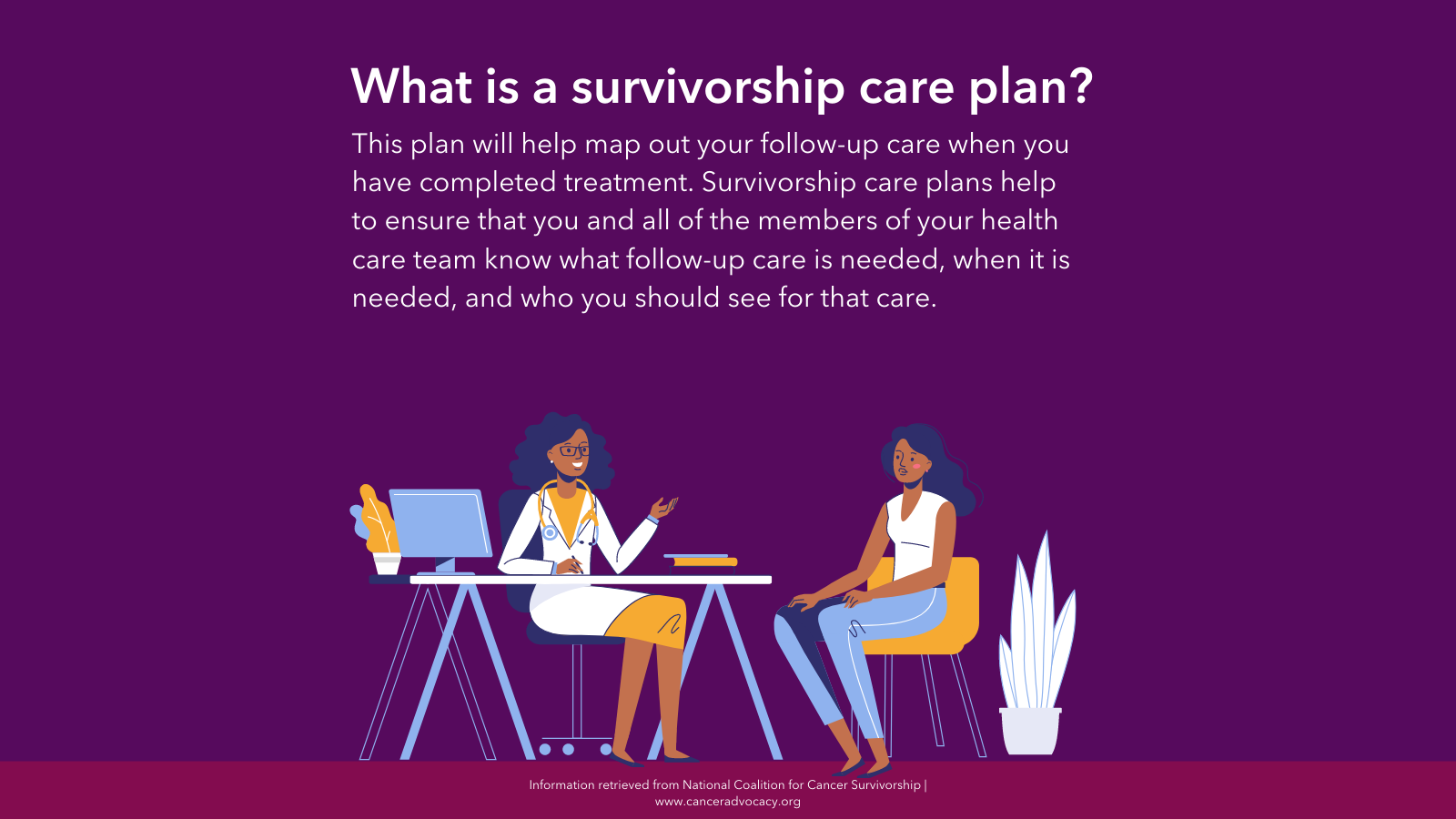 Download Image |
#Cancer and cancer treatment can have many different side effects. Review @TheNCI’s overview of common side effects and talk to your doctor about ways to minimize them. https://bit.ly/treatmentsideeffects #CompCancer #GWCC |  Download Image |
There are many things you can do to stay healthy after cancer treatment. The @AmericanCancer Society has answers to questions, health tips and more: http:// bit.ly/2m3eEWN #LifeAfterCancer #GWCC |  Download Image |
Communicating, finding information, and making decisions after #cancer can be tricky. @CancerAdvocacy can help you with these basic skills and more: http://bit.ly/2kRqvqs #GWCC |  Download Image |
Learn more about the role of a patient advocate. They can support #CancerSurvivors in asking questions and getting the best possible medical care. Read more about how this service can work for you: https://bit.ly/3hJgDNE #GWCC |  Download Image |
Sample Messages for Caregivers
| Message | Suggested Graphic |
|---|---|
#Cancer caregivers, you must maintain your own health to care for your loved one. Check out @CDCgov’s suggestions to help stay happy and healthy. Review and share: https://bit.ly/2WFCtsD #GWCC |  Download Image |
#Cancer #caregivers need resources to support survivors. You can share the @CancerAdvocacy Caring for the Caregiver toolkit to support the full team it takes to #fightcancer: https://bit.ly/2Zflyiz #GWCC |  Download Image |
People with a history of #cancer face many changes and considerations after cancer treatment. @TheNCI #LifeAfterCancer booklet is available as a guide for #survivors, family and friends: http://bit.ly/2kRD2KT #CompCancer #GWCC |  Download Image |
Sample Messages for Providers & Practitioners
| Message | Suggested Graphic |
|---|---|
Looking for the latest info on caring for people with a history of #cancer? #PrimaryCareProviders, check out this e-learning series from @GWCancer today: www.gwccacademy.com #cancer #CompCancer #GWCC | 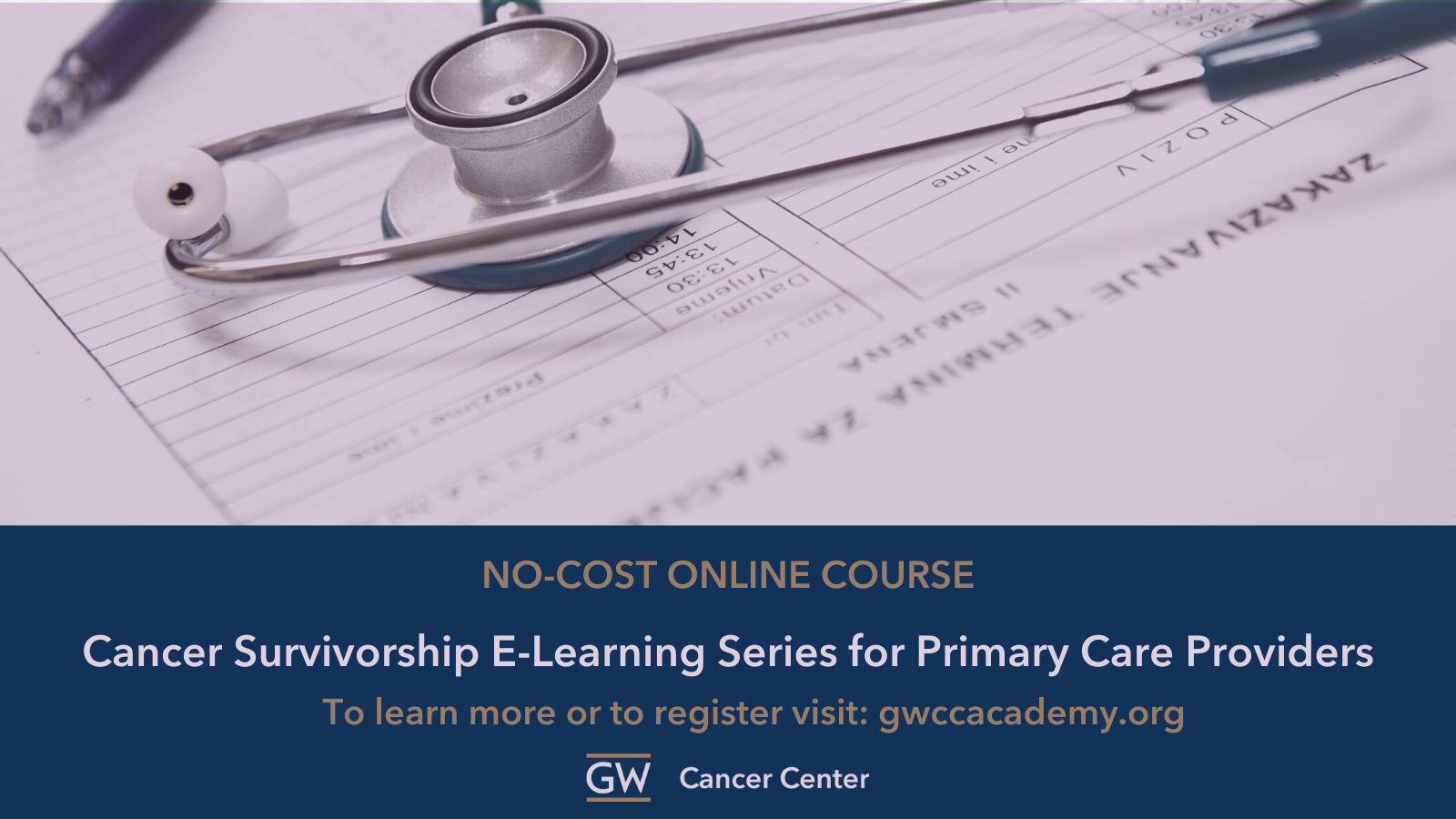 Download Image |
Providers, plan your patients’ #cancer care using the checklists, examples and tips from @CancerAdvocacy. https://bit.ly/2zQxRa5 #GWCC |  Download Image |
Use this template to share the best #resources with your patients with #cancer. Download the worksheet: http://bit.ly/2G8Zxc1 #CompCancer #GWCC |  Download Image |
Check out the National @CancerLGBT Network to review the needs and concerns of #LGBT #CancerSurvivors and access additional resources: https://bit.ly/2XgDPcs #healthequity #GWCC |  Download Image |
Sample Messages for COVID-19
| Message | Suggested Graphic |
|---|---|
People with a history of #cancer may be at higher risk for more serious infection if they get #COVID19. Lower your risk of infection by following @CDCgov guidance for cancer survivors and their families and caregivers: https://bit.ly/3Nvi7dv #GWCC |  Download Image |
#CancerCare Providers, check out this resource from @NCCN for managing distress and self-care during #COVID19: https://bit.ly/3aox2oJ #GWCC |  Download Image |
Sample Messages for Survivors
| Message | Suggested Graphic |
|---|---|
| After #cancertreatment, good communication with your physician and follow-up care remain essential. Use the National Cancer Institute’s suggested questions to discuss #LifeAfterCancer with your doctor: https://bit.ly/3g6rd0r #GWCC | 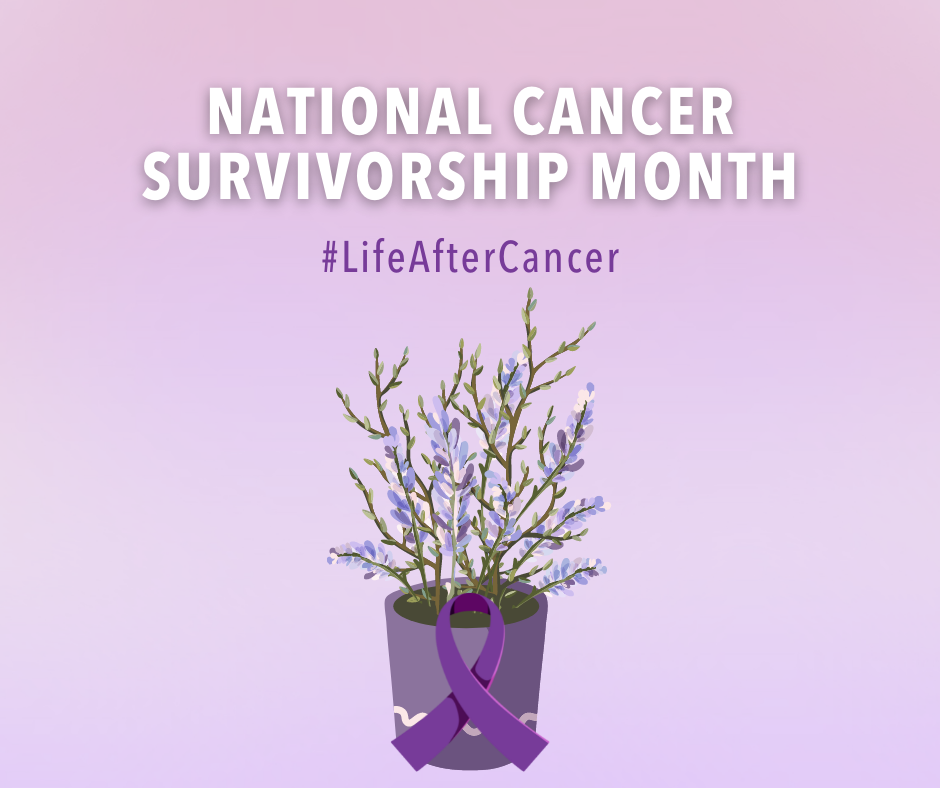 Download Image |
| #CancerSurvivors, check out these Cancer Care planning tools for cancer survivors from the National Coalition for Cancer Survivorship: https://bit.ly/2QHCeN9 #GWCC |  Download Image |
| #Cancer and the treatment process can impact your life in many ways. Review the National Cancer Institute’s management suggestions to learn more about how to minimize side effects and feel your best as you pursue #LifeAfterCancer: https://bit.ly/treatmentsideeffects #GWCC | 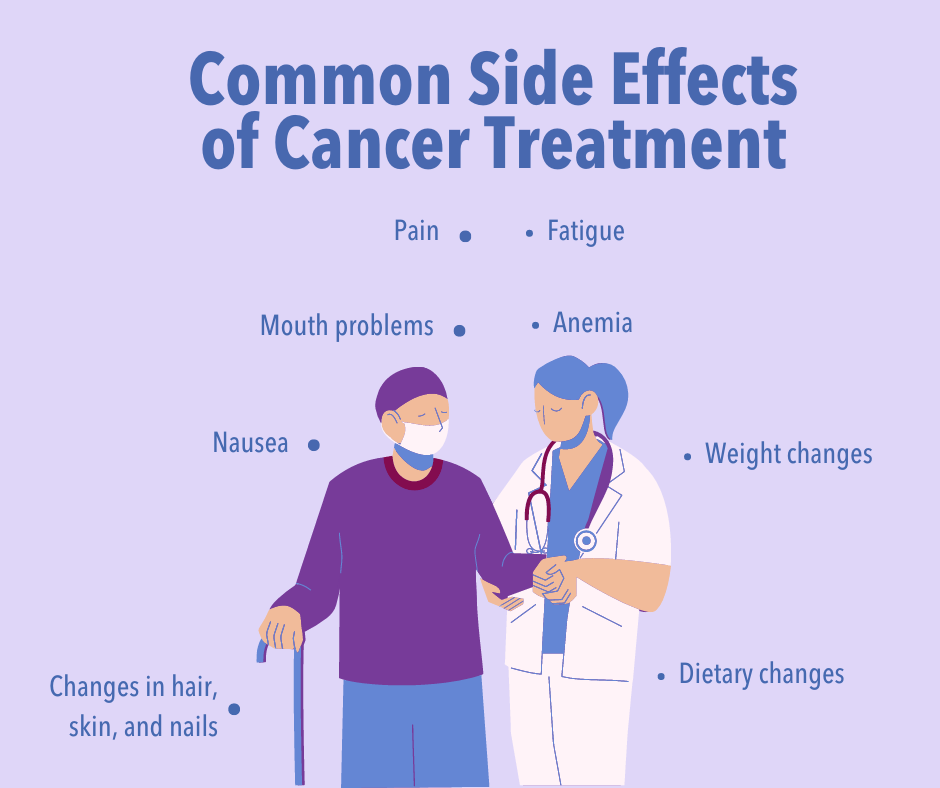 Download Image |
| There are many ways to stay #healthy after surviving #cancer. Along with joy and relief, you may feel some uncertainty about how to remain cancer-free after treatment. Learn how to stay healthy through #nutrition and #lifestyle changes as you move forward: http://bit.ly/2m3eEWN #GWCC |  Download Image |
| #Communicating, making decisions, and negotiating treatment options after a #cancer diagnosis can be difficult. Develop the skills you need to better meet and understand the challenges of cancer with this Cancer Survival Toolbox: http://bit.ly/2kRqvqs #GWCC |  Download Image |
| Consider enlisting the help of a #patient #advocate who can support you in asking questions and getting the best possible medical care. You can learn more about the role of a patient advocate and who can benefit from this service from the Patient Advocate Foundation. #GWCC https://bit.ly/3hJgDNE |  Download Image |
Sample Messages for Caregivers
| Message | Suggested Graphic |
|---|---|
| #Cancer #caregivers, you must maintain your health so that you can take care of your loved one. Use the CDC’s tips to stay happy and healthy as a cancer caregiver. Review and share: https://bit.ly/2WFCtsD #GWCC |  Download Image |
| Oncologists, pharmacists, primary care doctors, nurses, family, friends, caregivers, and more: It takes a team to fight #cancer. The National Coalition for Cancer Survivorship’s Caring for the Caregiver toolkit offers suggestions for #caregivers to find resources and improve their skills. https://bit.ly/2Zflyiz #GWCC |  Download Image |
| The National Cancer Institute’s guide for people with a history of #cancer, Facing Forward: Life After Cancer Treatment, is a multifaceted guide on what’s next after #cancer treatment. Download the PDF, Kindle or eBook to help you answer questions and manage doctor visits: http://bit.ly/2kRD2KT #GWCC | 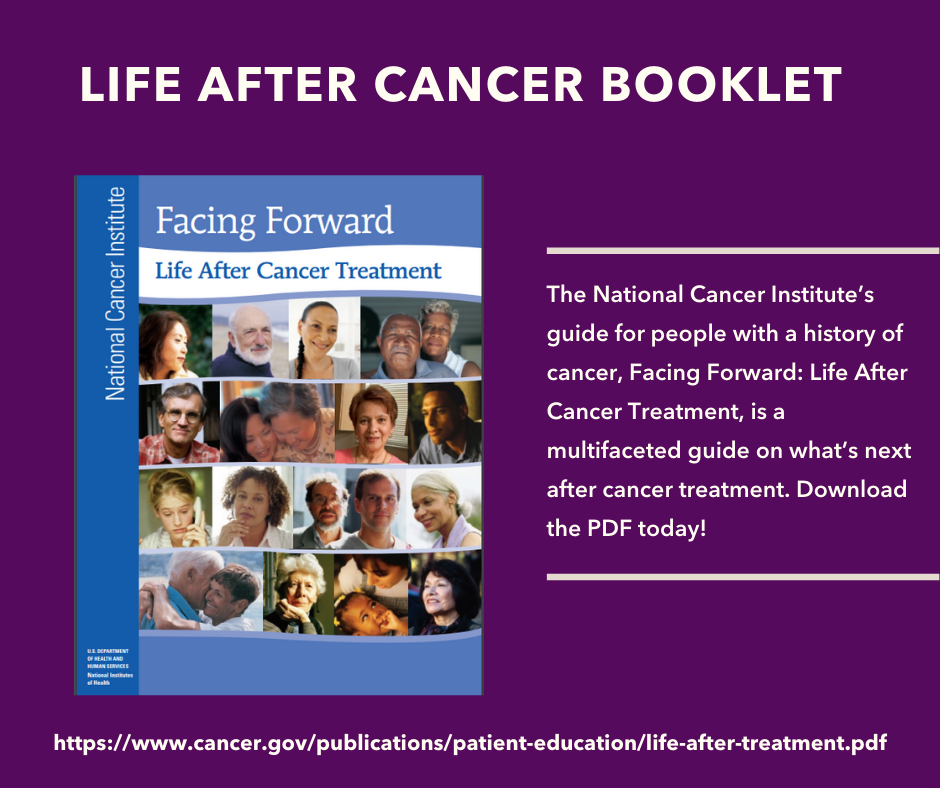 Download Image |
Sample Messages for Providers & Practitioners
| Message | Suggested Graphic |
|---|---|
| As a #primary care provider, staying up to date on how to best care for people with a history of #cancer can be difficult. Good news: a course is available from the GW Cancer Center’s Online Academy! Get the latest care information today: www.gwccacademy.com #GWCC |  Download Image |
| Use checklists, examples, and tips from the National Coalition for Cancer Survivorship to help your patients with cancer create a #cancer care plan https://bit.ly/2zQxRa5 #GWCC |  Download Image |
| Support your patient’s #empowerment and point them in the right direction. Help your patients as they transition out of formal #cancer treatment using this streamlined #resource list: http://bit.ly/2G8Zxc1 #GWCC |  Download Image |
| LGBTQI+ people with a history of #cancer want specialized support. Review the resources from the National LGBT Cancer Network to learn about their nuanced needs and concerns to better support your #LGBTQI patients: https://bit.ly/2XgDPcs #GWCC |  Download Image |
Sample Messages for COVID-19
| Message | Suggested Graphic |
|---|---|
| People with a history of #cancer may be at higher risk for more serious infection if they get COVID-19. Lower your risk of infection by following this CDC guidance for cancer survivors and their families and caregivers: https://bit.ly/3Nvi7dv #GWCC |  Download Image |
| #Cancer Care Providers, check out this resource from the National Comprehensive Cancer Network for managing #distress and #self-care during COVID-19: https://bit.ly/3aox2oJ #GWCC |  Download Image |
| Message | Suggested Graphic |
|---|---|
| We all envision a world where we defeat #cancer. During National #Cancer #Survivorship month, consider how you can show your support for everyone who has fought cancer by using these National Cancer Survivorship Resource Center #advocacy and #policy tools. #GWCC https://bit.ly/3fWpXNj |  Download Image |
| #Oncology and cancer care professionals: #Survivorship care plans are a valuable tool for increasing communication between collaborating #health care professionals and between health care professionals and people with a history of #cancer. The National Coalition for Cancer Survivorship has helpful information. Learn more and access customizable #survivorship #care plan templates: http://bit.ly/2l1Gp4q #GWCC |  Download Image |
| June 5, 2022 is National Cancer #Survivors Day! Spread the word about #cancer #survivorship with this summary from the American Cancer Society: https://bit.ly/2RjM9Jr #GWCC |  Download Image |
Sample Messages for Survivors
| Message | Suggested Graphic |
|---|---|
| After #cancertreatment, good communication and follow-up care remain essential. Check out @nationalcancerinstitute for suggested questions to discuss #LifeAfterCancer with your doctor #CompCancer #CancerSurvivors #GWCC |  Download Image |
| #CancerSurvivors, check out these cancer care planning tools from @cancersurvivorship! Advocate for quality cancer care for yourself and everyone touched by cancer. Visit canceradvocacy.org/resources/care-planning-for-cancer-survivors #CancerSurvivors #LifeAfterCancer #GWCC |  Download Image |
| #Cancer and cancer treatment can have many different side effects. Review @nationalcancerinstitute’s overview of common side effects and talk to your doctor about ways to minimize them. Visit cancer.gov/about-cancer/treatment/side-effects for more info. #LifeAfterCancer #GWCC |  Download Image |
| There are many things you can do to stay healthy after #cancer treatment. The @AmericanCancerSociety has answers to questions, health tips and more. Visit cancer.org/treatment/survivorship-during-and-after-treatment/be-healthy-after-treatment for more info! #LifeAfterCancer #GWCC |  Download Image |
| Communicating, finding information, and making decisions after a #cancer diagnosis can be tricky. @CancerSurvivorship can help you with these basic skills and more: canceradvocacy.org/resources/cancer-survival-toolbox/ #CancerSurvivor #GWCC | 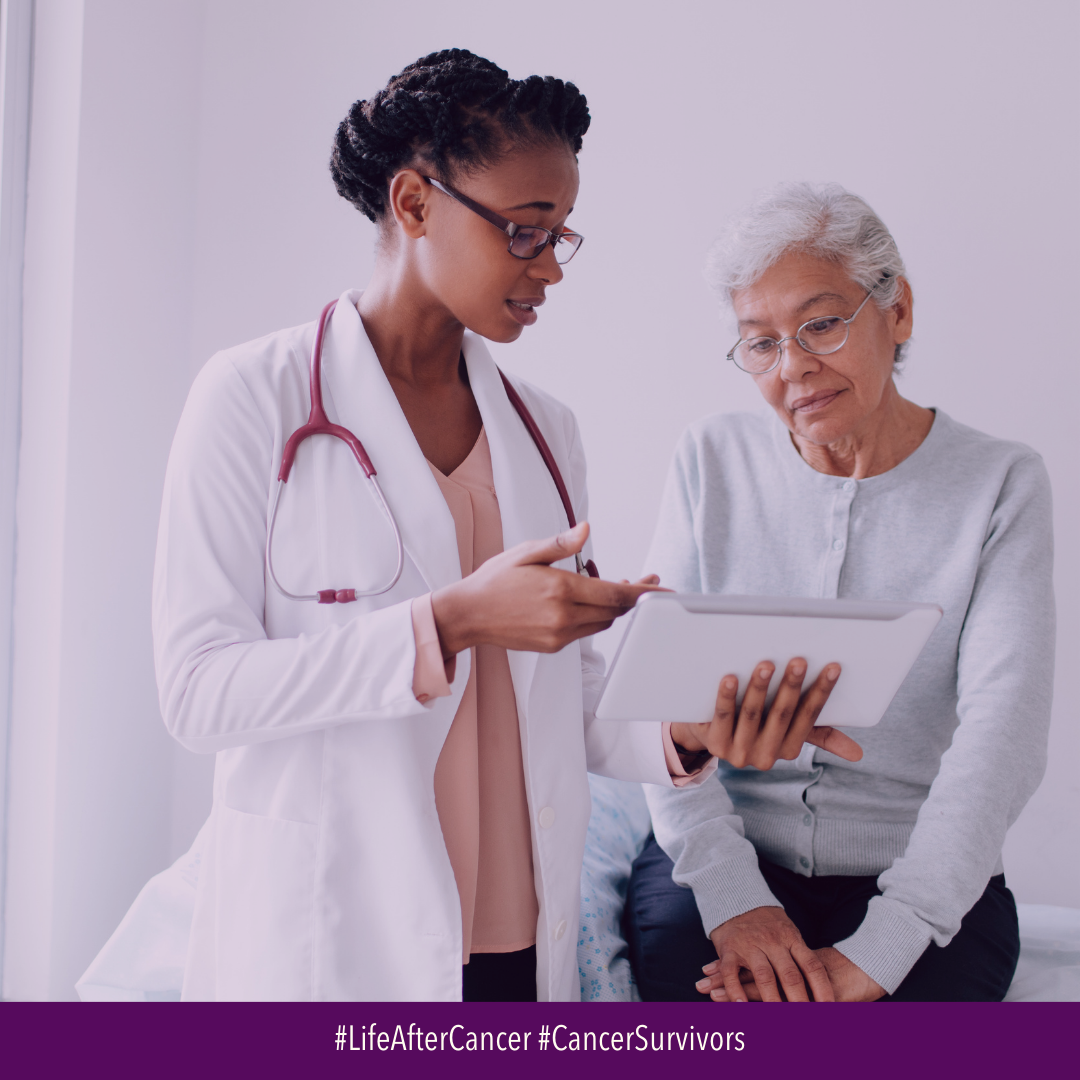 Download Image |
| Learn more about the role of a #PatientAdvocate. They can support #CancerSurvivors in asking questions and getting the best possible medical care. Read more about how this service can work for you at patientadvocate.org. #GWCC |  Download Image |
Sample Messages for Caregivers
| Message | Suggested Graphic |
|---|---|
| #Cancer caregivers, you must maintain your own health to care for your loved one. Check out @CDC_Cancer’s suggestions to help stay happy and healthy. Review and share: cdc.gov/cancer/survivors/caregivers/caring-for-yourself. #GWCC |  Download Image |
| #Cancer #caregivers need resources to support survivors. You can share the @CancerAdvocacy Caring for the Caregiver toolkit to support the full team it takes to #fightcancer. Check out canceradvocacy.org for more info. #GWCC |  Download Image |
| People with a history of #cancer face many changes and considerations after cancer treatment. @NationalCancerInstitute #LifeAfterCancer booklet is available as a guide for survivors, family and friends. Check it out at cancer.gov/publications/patient-education/life-after-treatment.pdf #CompCancer #GWCC |  Download Image |
Sample Messages for Providers & Practitioners
| Message | Suggested Graphic |
|---|---|
| #PrimaryCareProviders, looking for the latest info on caring for people with a history of #cancer? Primary care providers, check out this e-learning series at gwccacademy.com #cancer #CompCancer #GWCC |  Download Image |
| #Providers, plan your patients’ #cancer care using the checklists, examples and tips from @CancerAdvocacy. Visit canceradvocacy.org/resources/tools-for-care-providers/planning-your-patients-care for more info. #GWCC | 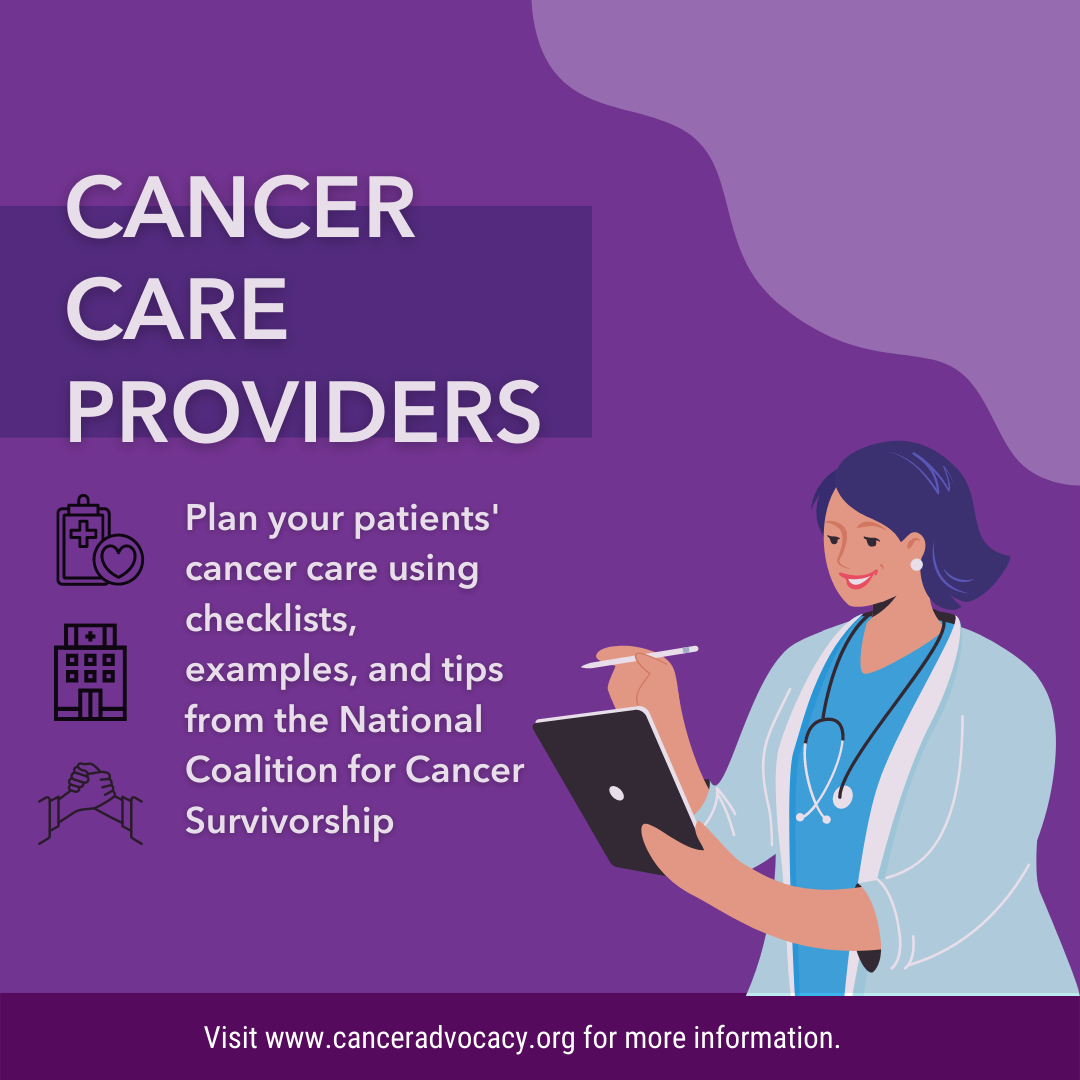 Download Image |
| #CancerCareProviders, use this template to share the best resources with your patients with #cancer. Download “A Cancer Survivor’s Prescription for Finding Information” from @AmericanCancerSociety #CompCancer #GWCC |  Download Image |
| #CancerCareProviders, check out the National @CancerLGBT Network to review the needs and concerns of #LGBT #CancerSurvivors and access additional resources #healthequity #GWCC |  Download Image |
Sample Messages for COVID-19
| Message | Suggested Graphic |
|---|---|
| People with a history of #cancer may be at higher risk for more serious infection if they get #COVID19. Lower your risk of infection by following @CDCgov guidance at cdc.gov/cancer/dcpc/about/covid-19. #GWCC |  Download Image |
| #CancerCareProviders, check out resources from @NCCNorg for managing distress and self-care during #COVID19. Visit ncccn.org for more info. #GWCC |  Download Image |
Download All Messages and Graphics
Social media management tools like Hootsuite and Sprout Social offer bulk scheduling options for uploading multiple messages at once. The spreadsheets below can be adapted to fit multiple scheduling platforms or services. They are currently formatted to work with Sprout Social’s bulk scheduling option. Please review the bulk scheduling format requirements for your specific platform before posting. Messages are sorted by network.
Download All Facebook Messages
Download All LinkedIn Messages
Download All Instagram Messages
If you would like to download all images in this social media toolkit, click on each network below for a zip file with each network’s graphics. Please note that these image sizes are slightly smaller than the links above due to file size limitations. If you would like to download full resolution versions, simply click on the “Download Graphic” link below each image in the message tables above.
Download All Facebook Graphics
Download All LinkedIn Graphics
Download All Instagram Graphics
References
- National Coalition for Cancer Survivorship (2021). Our History. https://canceradvocacy.org/about/our-history/
- National Cancer Institute. (n.d.). NCI Dictionary of cancer terms – definition of “survivor” [webpage]. Retrieved from https://www.cancer.gov/publications/dictionaries/cancer-terms/def/survivor
- Centers for Disease Control and Prevention (2021a). Supporting Cancer Survivors and Caregivers. https://www.cdc.gov/cancer/ncccp/priorities/cancer-survivor-caregiver.htm
- National Cancer Survivors Day Foundation (2022). About National Cancer Survivors Day®. https://ncsd.org/about-us/
- U.S. Cancer Statistics Working Group, Centers for Disease Control and Prevention (2021). United States Cancer Statistics Working Group, U.S. Cancer Statistics Data Visualizations Tool, based on 2020 submission data (1999-2018). Retrieved from https://gis.cdc.gov/Cancer/USCS/DataViz.html.
- American Cancer Society. (2022). Cancer Facts and Figures: 2022. Retrieved from https://www.cancer.org/content/dam/cancer-org/research/cancer-facts-and-statistics/annual-cancer-facts-and-figures/2022/2022-cancer-facts-and-figures.pdf
- Centers for Disease Control and Prevention. (2020, March 12). Annual report to the nation: Cancer death rates continue to decline. Retrieved from https://www.cdc.gov/media/releases/2020/p0312-annual-report.html
- Islami, F., Ward, E. M., Sung, H., Cronin, K. A., Tangka, F. K. L., Sherman, R. L., Zhao, J., Anderson, R. N., Henley, S. J., Yabroff, K. R., Jemal, A., & Benard, V. B. (2021). Annual Report to the Nation on the Status of Cancer, Part 1: National Cancer Statistics. JNCI : Journal of the National Cancer Institute, 113(12), 1648–1669. https://doi.org/10.1093/jnci/djab131
- National Cancer Institute (2022). Statistics and Graphs. Office of Cancer Survivorship. https://cancercontrol.cancer.gov/ocs/statistics#stats
- MedStar Health (2022). Cancer Survivorship Program. https://www.medstarhealth.org/services/cancer-survivorship-program
- National Institute of Medicine. (2005). From cancer patient to cancer survivor: Lost in transition. Hewitt, M., Greenfield, S., & Stovall, E. (Eds.). Washington, DC: The National Academies Press. Retrieved from https://www.nap.edu/read/11468/chapter/1
- Chae J. (2017). The role of intolerance of uncertainty in the repeated exposure to cancer information. Journal of psychosocial oncology, 35(3), 335–345. https://doi.org/10.1080/07347332.2016.1277822
- Underwood, J.M., Townsend, J.S., Stewart, S.L., Buchannan, N., Ekwueme, D.U., Haskins, N.A….Fairley, T.L. (2012). Surveillance of demographic characteristics and health behaviors among adult cancer survivors – behavioral risk factor surveillance system, United States, 2009. Morbidity and Mortality Weekly Report, 61(SS01), 1-23. Retrieved from http://www.cdc.gov/mmwr/preview/mmwrhtml/ss6101a1.htm
- Sauer, A. G., Siegel, R. L., Jemal, A., & Fedewa, S. A. (2017). Updated review of prevalence of major risk factors and use of screening tests for cancer in the united states. Cancer epidemiology, biomarkers & prevention: a publication of the American Association for Cancer Research, cosponsored by the American Society of Preventive Oncology, 26(8), 1192–1208. https://doi.org/10.1158/1055-9965.EPI-17-0219
- Briant, K.J., Halter, A., Marchello, N., Escareno, M., & Thompson, B. (2016). The power of digital storytelling as a culturally relevant health promotion tool. Health Promotion Practice, 17(6), 793-801. https://doi.org/10.1177/1524839916658023
- National Coalition for Cancer Survivorship. (n.d.) Becoming a self-advocate [webpage]. https://www.canceradvocacy.org/resources/advocating-for-yourself/becoming-a-self-advocate-2/
- Pel-Littel, Snaterse, M., Teppich, N. M., Buurman, B. M., van Etten-Jamaludin, F. S., van Weert, J. C. M., Minkman, M. M., & Scholte op Reimer, W. J. M. (2021). Barriers and facilitators for shared decision making in older patients with multiple chronic conditions: a systematic review. BMC Geriatrics, 21(1), 112–112. https://doi.org/10.1186/s12877-021-02050-y
- Mayer, D.K., Nasso, S. F., & Earp, J. A. (2017). Defining cancer survivors, their needs, and perspectives on survivorship health care in the USA. The Lancet Oncology, 18(1), e11–e18. https://doi.org/10.1016/S1470-2045(16)30573-3
- Josfeld, L., Keinki, C., Pammer, C., Zomorodbakhsch, B., & Hübner, J. (2021). Cancer patients’ perspective on shared decision-making and decision aids in oncology. Journal of cancer research and clinical oncology, 147(6), 1725–1732. https://doi.org/10.1007/s00432-021-03579-6
- Irfan, K. S., Farhana, I., Maya, N., Abdullah, A., & Gominda, P. (2018). Family physicians’ utility of social media: a survey comparison among family medicine residents and physicians. African Health Sciences, 18(3), 817-827. Retrieved from https://www.ncbi.nlm.nih.gov/pmc/articles/PMC6307000/
- Bhaskar, S. (2017). Examining physician use of social media in 2017. Retrieved from https://www.pm360online.com/examining-physician-use-of-social-media-in-2017/
- Nerminathan, A., Harrison, A., Phelps, M., Scott, K. M., & Alexander, S. (2017). Doctors’ use of mobile devices in the clinical setting: a mixed methods study. Internal medicine journal, 47(3), 291-298. https://onlinelibrary.wiley.com/doi/full/10.1111/imj.13349
- Hazzam, J. & Lahrech, A. (2018). Health care professionals’ social media behavior and the underlying factors of social media adoption and use: quantitative study. J Med Internet Res, 20(11):e12035 Retrieved from https://www.jmir.org/2018/11/e12035/
- Fogelson, N. S., Rubin, Z. A., & Ault, K. A. (2013, September). Beyond Likes and Tweets: An In-depth Look at the Physician Social Media Landscape. Clinical Obstetrics and Gynecology, 56(3), 495-508. Retrieved from https://journals.lww.com/clinicalobgyn/Abstract/2013/09000/Beyond_Likes_and_Tweets___An_In_depth_Look_at_the.11.aspx
- Jefford, M., Koczwara, B., Emery, J., Thornton-Benko, E., & Vardy, J. (2020). The important role of general practice in the care of cancer survivors. Australian Journal of General Practice, 49(5), 289–292. https://doi.org/10.31128/AJGP-10-19-5133
- Jain, J., Qorri, B., & Szewczuk, M. R. (2019). The crucial role of primary care providers in the long-term follow-up of adult survivors of childhood cancer. Cancer Management and Research, 11, 3411-3418. https://doi.org/10.2147/CMAR.S197644
- Chaput, G., Med, C. P., & Sussman, J. (2019). Integrating primary care providers through the seasons of survivorship. Current oncology (Toronto, Ont.), 26(1), 48–54. https://doi.org/10.3747/co.26.4687
- National Cancer Institute. (2020). Cancer disparities. Retrieved August 11, 2021 from https://www.cancer.gov/about-cancer/understanding/disparities
- White-Means, S., and Osmani, A. R. (2017). Racial and ethnic disparities in patient-provider communication with breast cancer patients: Evidence from 2011 MEPS and experiences with cancer supplement. INQUIRY: The Journal of Health Care Organization, Provision, and Financing, 54, 1-17. https://doi.org/10.1177/0046958017727104
- Office of Disease Prevention and Health Promotion (n.d.) Healthy People 2030-Cancer Objectives. https://health.gov/healthypeople/objectives-and-data/browse-objectives/cancer
- Lee Smith, J., & Hall, I. J. (2015). Advancing Health Equity in Cancer Survivorship: Opportunities for Public Health. American journal of preventive medicine, 49(6 Suppl 5), S477–S482. https://doi.org/10.1016/j.amepre.2015.08.008
- American Association for Cancer Research (2020). AACR Cancer Disparities Progress Report 2020. https://cancerprogressreport.aacr.org/wp-content/uploads/sites/2/2020/09/AACR_CDPR_2020.pdf
- Centers for Disease Control and Prevention (2021). About Social Determinants of Health (SDOH). Retrieved from https://www.cdc.gov/socialdeterminants/about.html
- National Cancer Institute (n.d.). SEER Cancer Stat Facts: Cancer Among Adolescents and Young Adults (AYAs). National Cancer Institute. Bethesda, MD. Retrieved April 28, 2022 from https://seer.cancer.gov/statfacts/html/aya.html
- American Cancer Society. Cancer Treatment & Survivorship Facts & Figures 2019-2021. Atlanta: American Cancer Society; 2019. https://www.cancer.org/content/dam/cancer-org/research/cancer-facts-and-statistics/cancer-treatment-and-survivorship-facts-and-figures/cancer-treatment-and-survivorship-facts-and-figures-2019-2021.pdf
- National Cancer Institute (2020). Adolescents and Young Adults with Cancer. https://www.cancer.gov/types/aya
- Children’s Oncology Group (2018). Long-Term Follow-Up Guidelines for Survivors of Childhood, Adolescent, and Young Adult Cancers, Version 5.0 (October 2018). http://survivorshipguidelines.org/
- American Cancer Society. Cancer Facts & Figures for African American/Black People 2022-2024. Atlanta: American Cancer Society, 2022. https://www.cancer.org/content/dam/cancer-org/research/cancer-facts-and-statistics/cancer-facts-and-figures-for-african-americans/2022-2024-cff-aa.pdf
- Beebe-Dimmer, J. L., Albrecht, T. L., Baird, T. E., Ruterbusch, J. J., Hastert, T., Harper, F., Simon, M. S., Abrams, J., Schwartz, K. L., & Schwartz, A. G. (2019). The Detroit Research on Cancer Survivors (ROCS) Pilot Study: A Focus on Outcomes after Cancer in a Racially Diverse Patient Population. Cancer epidemiology, biomarkers & prevention : a publication of the American Association for Cancer Research, cosponsored by the American Society of Preventive Oncology, 28(4), 666–674. https://doi.org/10.1158/1055-9965.EPI-18-0123
- Kwan, M.L., Yao, S., Lee, V. S., Roh, J. M., Zhu, Q., Ergas, I. J., Liu, Q., Zhang, Y., Kutner, S. E., Quesenberry, C. P., Ambrosone, C. B., & Kushi, L. H. (2016). Race/ethnicity, genetic ancestry, and breast cancer-related lymphedema in the Pathways Study. Breast Cancer Research and Treatment, 159(1), 119–129. https://doi.org/10.1007/s10549-016-3913-x
- Hastert, T.A., McDougall, J. A., Strayhorn, S. M., Nair, M., Beebe‐Dimmer, J. L., & Schwartz, A. G. (2021). Social needs and health‐related quality of life among African American cancer survivors: Results from the Detroit Research on Cancer Survivors study. Cancer, 127(3), 467–475. https://doi.org/10.1002/cncr.33286
- National Cancer Institute (n.d.). Surveillance Epidemiology and End Results (SEER) Program. Survival database: All Cancer Sites Combined, SEER 5-Year Relative Survival Rates, 2012-2018. Retrieved April 28, 2022 from www.seer.cancer.gov
- Chee, W. & Im, E.-O. (2021). Sub-Ethnicity and Survivorship Experience: Asian American Breast Cancer Survivors. Western Journal of Nursing Research, 19394592110319–1939459211031990. https://doi.org/10.1177/01939459211031990
- Warmoth, K., Cheung, B., You, J., Yeung, N. C., & Lu, Q. (2017). Exploring the social needs and challenges of Chinese American immigrant breast cancer survivors: A qualitative study using an expressive writing approach. International Journal of Behavioral Medicine, 24(6), 827–835. https://doi.org/10.1007/s12529-017-9661-4
- Acoba, J.D., Tamashiro, S., & Chock, M. (2020). Perceived value of cancer survivorship care among Asians and Native Hawaiian/Pacific Islanders. Journal of Clinical Oncology, 38(15_suppl), e22522–e22522. https://doi.org/10.1200/JCO.2020.38.15_suppl.e22522
- Asian & Pacific Islander American Health Forum (2017, March). Making Cancer Survivorship Care Plans More Inclusive of Asian American, Native Hawaiian, and Pacific Islander Communities. https://www.apiahf.org/wp-content/uploads/2017/03/March-2017_Making-Cancer-Survivorship-Care-Plans-More-Inclusive-of-AANHPI-Communities-1.pdf
- Sieloff, B. (2022). Webinar: Cancer Survivorship Care [webinar]. National Native Network. https://keepitsacred.itcmi.org/2022/02/webinar-cancer-survivorship-care/
- Haozous, E. A., Doorenbos, A., Alvord, L. A., Flum, D. R., & Morris, A. M. (2016). Cancer Journey for American Indians and Alaska Natives in the Pacific Northwest . Oncology nursing forum, 43(5), 625–635. https://doi.org/10.1188/16.ONF.625-635
- Burnette, C. E., Roh, S., Liddell, J., & Lee, Y. S. (2019). American Indian Women Cancer Survivor’s Needs and Preferences: Community Support for Cancer Experiences. Journal of cancer education : the official journal of the American Association for Cancer Education, 34(3), 592–599. https://doi.org/10.1007/s13187-018-1346-4
- Bastian, T.D. & Burhansstipanov, L. (2020). Sharing Wisdom, Sharing Hope: Strategies Used by Native American Cancer Survivors to Restore Quality of Life. JCO Global Oncology, 6(6), 161–166. https://doi.org/10.1200/JGO.19.00215
- Kronenfeld, J.P., Graves, K. D., Penedo, F. J., & Yanez, B. (2021). Overcoming Disparities in Cancer: A Need for Meaningful Reform for Hispanic and Latino Cancer Survivors. The Oncologist (Dayton, Ohio), 26(6), 443–452. https://doi.org/10.1002/onco.13729
- Santee, E., King, K. A., Vidourek, R. A., & Merianos, A. L. (2018). Health Care Access and Health Behavior Quality of Life among Hispanic/Latino-American Cancer Survivors. Applied Research in Quality of Life, 15(3), 637–650. https://doi.org/10.1007/s11482-018-9677-1
- Advani, P., Bondy, M., Thompson, P. A., Martínez, M. E., Nodora, J. N., Vernon, S. W., Diamond, P., Burnett, J., & Brewster, A. M. (2018). Impact of acculturation on breast cancer treatment and survivorship care among Mexican American patients in Texas. Journal of Cancer Survivorship, 12(5), 659–668. https://doi.org/10.1007/s11764-018-0703-y
- Valle, C.G., Padilla, N., Gellin, M., Manning, M., Reuland, D. S., Rios, P., Lane, G., Lewis, V., & Rosenstein, D. L. (2019). Ahora qué?: Cultural Adaptation of a Cancer Survivorship Intervention for Latino/a Cancer Survivors. Psycho-Oncology (Chichester, England), 28(9), 1854–1861. https://doi.org/10.1002/pon.5164
- National LGBT Cancer Network (n.d.) Cancer and the LGBT Community. https://cancer-network.org/cancer-information/cancer-and-the-lgbt-community/
- Scout, NFN; Rhoten, B. (2021) OUT: The National Cancer Survey, Summary of Findings. Providence, RI: National LGBT Cancer Network https://cancer-network.org/out-the-national-cancer-survey/

